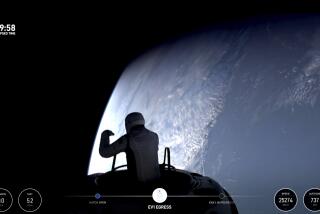NASA’s New Horizons just flew past the most distant world visited by humankind and it went perfectly
It’s official.
Four billion miles from Earth, NASA’s New Horizons spacecraft sped past a small, cold Kuiper Belt object known as Ultima Thule on Monday night, successfully collecting data on the most distant world ever visited by humankind.
The flyby occurred at 9:33 p.m. PST New Year’s Eve, exactly as planned, but mission leaders didn’t receive word that the spacecraft had survived the encounter until 7:30 a.m. Tuesday morning.
“Thousands of operations on the spacecraft had to work correctly to get this data, and now we know they did,” said Alan Stern, the principal investigator for the mission. “I don’t know about you, but I’m really liking this 2019 thing so far.”
This is the second time that New Horizons has successfully flown past an object in the outer reaches of the solar system. In July 2015 the spacecraft sped past Pluto, giving humanity its first up close look at the dwarf planet and revealing its diverse geography.
The Pluto flyby was New Horizon’s primary mission, but Alice Bowman, the operations manager, said she was more nervous while waiting for confirmation that the Ultima Thule flyby had gone off without a hitch.
“I think it had to do with the timing,” she said. “We celebrated this flyby at night, when it happened, but before we had gotten the signal back.”
The team had to wait overnight for the spacecraft to send the message that all its instruments were healthy and that its servers were filled with science data.
The nail-biting delay was stressful, but inevitable.
New Horizons was not in contact with Earth during the flyby to ensure all its energy was directed toward collecting data, mission planners said.
And when the spacecraft finally did send the all-clear message to Earth, it took the signal 6½ hours moving at the speed of light to traverse the vast ocean of space between it and us.
When it was finally received by radio telescopes in Madrid, Bowman was elated.
“We did it again,” she said. “Fantastic.”
Ultima Thule is located deep in the Kuiper Belt, a doughnut-shaped region of space beyond the orbit of Neptune that is dotted with hundreds of thousands of icy objects.
The small world, about 20 miles in diameter, is part of a group of objects that populate an area of the Kuiper Belt known as the cold classical belt. Scientists believe those worlds have remained in a stable, circular orbit around the sun for 4.5 billion years, frozen in time at the far reaches of the solar system.
For that reason, Ultima Thule could represent the most pristine example yet of the original disk of gas and dust out of which the planets formed.
The first close-up images of the icy relic should be coming down to Earth Tuesday evening, mission planners said. They will be shared with the public beginning Wednesday.
“Signals are coming back from across the solar system as we speak,” Stern said. “Overnight the science team will analyze the first high-resolution images and we’ll share them with you tomorrow.”
In the meantime, the science team shared a newly released image taken by New Horizons from a distance of about 500,000 miles from Ultima Thule. It is pixelated and blurry, but it clearly shows that the object is made up of two circular lobes stuck together or perhaps two smaller objects that are orbiting each other.
“It’s a pixelated blob, but it’s a better pixelated blob than we had before,” said Hal Weaver, New Horizons project scientist. “Ultima Thule is finally beginning to reveal its secrets.”
By stringing a few of these images together, the scientists were also able to determine that the oblong Ultima Thule is rotating like a propeller from the perspective of the spacecraft. This explains why the amount of light it reflects does not change over time. The same side of the object is always facing New Horizons.
But aside from these few revelations, New Horizon’s science team leaders refused to make predictions about what the first high-resolution images might show.
Nobody knows yet if this world is active or dormant, if its surface will be smooth or pockmarked by craters.
It might have moons or rings.
“It will all be revealed by tomorrow or the next day,” Weaver said. “Ultima Thule will be turned into a real world.”
Do you love science? I do! Follow me @DeborahNetburn and “like” Los Angeles Times Science & Health on Facebook.







